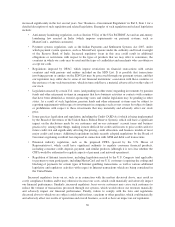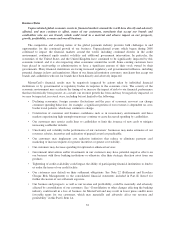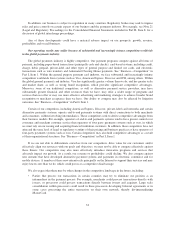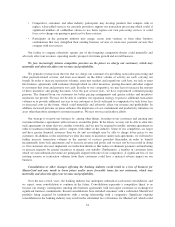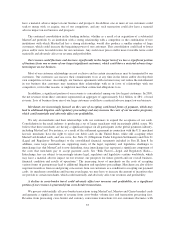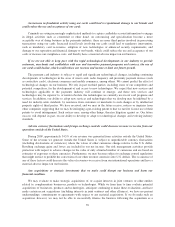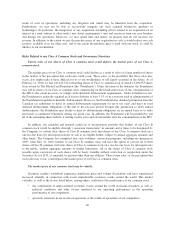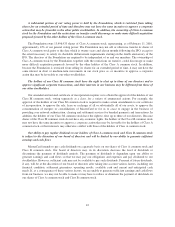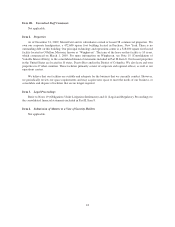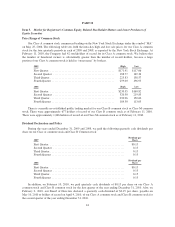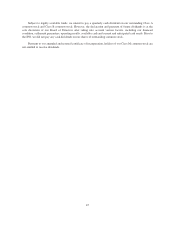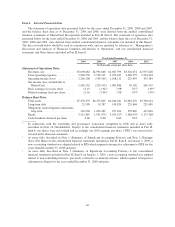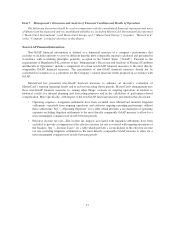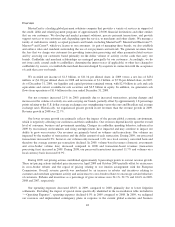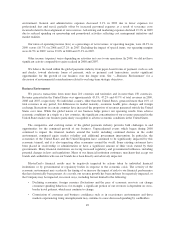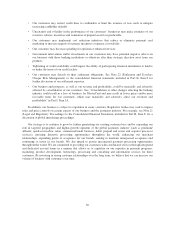MasterCard 2009 Annual Report Download - page 50
Download and view the complete annual report
Please find page 50 of the 2009 MasterCard annual report below. You can navigate through the pages in the report by either clicking on the pages listed below, or by using the keyword search tool below to find specific information within the annual report.result of costs of operations, including any litigation risk which may be inherited from the acquisition.
Furthermore, we may not be able to successfully integrate any such acquired businesses, products or
technologies. In particular, the integration of any acquisition (including efforts related to an acquisition of an
interest in a joint venture or other entity) may divert management’s time and resources from our core business
and disrupt our operations. Moreover, we may spend time and money on projects that do not increase our
revenue. In addition, to the extent we pay the purchase price of any acquisition in cash, it would reduce our cash
reserves available to us for other uses, and to the extent the purchase price is paid with our stock, it could be
dilutive to our stockholders.
Risks Related to our Class A Common Stock and Governance Structure
Future sales of our shares of Class A common stock could depress the market price of our Class A
common stock.
The market price of our Class A common stock could decline as a result of sales of a large number of shares
in the market or the perception that such sales could occur. These sales, or the possibility that these sales may
occur, also might make it more difficult for us or our stockholders to sell equity securities in the future. As of
February 11, 2010, we had 110,441,542 outstanding shares of Class A common stock of which 13,496,933 shares
were owned by The MasterCard Foundation (the “Foundation”). Under the terms of the donation, the Foundation
may sell its shares of our Class A common stock commencing on the fourth anniversary of the consummation of
the IPO to the extent necessary to comply with charitable disbursement requirements. Under Canadian tax law,
the Foundation is generally required each year to disburse at least 3.5% of its assets not used in administration of
the Foundation in qualified charitable disbursements. However, the Foundation has obtained permission from the
Canadian tax authorities to defer its annual disbursement requirement for up to ten years and meet its total
deferred disbursement obligations at the end of the ten-year period. Despite this permission to defer annual
disbursements, the Foundation may decide to meet its disbursement obligations on an annual basis or to settle
previously accumulated obligations during any given year. In addition, the Foundation will be permitted to sell
all of the remaining shares held by it starting twenty years and eleven months after the consummation of the IPO.
In addition, our amended and restated certificate of incorporation provides that holders of our Class B
common stock would be eligible, through “conversion transactions” in amounts and at times to be designated by
the Company, to convert their shares of Class B common stock into shares of our Class A common stock on a
one-for-one basis for subsequent transfer or sale to an eligible holder, subject to annual aggregate amounts and
other limits. The Company has completed four such voluntary conversion programs, including one program in
2009. After May 31, 2010, holders of our Class B common stock will have the option to convert all of their
shares of Class B common stock into shares of Class A common stock on a one-for-one basis for subsequent sale
to the public, without aggregate amounts or similar limitations. All of the shares of Class A common stock
issuable upon conversion of such shares will be freely tradable without restriction or registration under the
Securities Act of 1933, as amended, by persons other than our affiliates. These future sales, or the perception that
such sales may occur, could depress the market price of our Class A common stock.
The market price of our common stock may be volatile.
Securities markets worldwide experience significant price and volume fluctuations and have experienced
increased volatility in connection with recent unpredictable economic events around the world. This market
volatility, as well as the factors listed below, among others, could affect the market price of our common stock:
• the continuation of unprecedented economic events around the world in financial markets as well as
political conditions and other factors unrelated to our operating performance or the operating
performance of our competitors;
• quarterly variations in our results of operations or the results of operations of our competitors;
40


